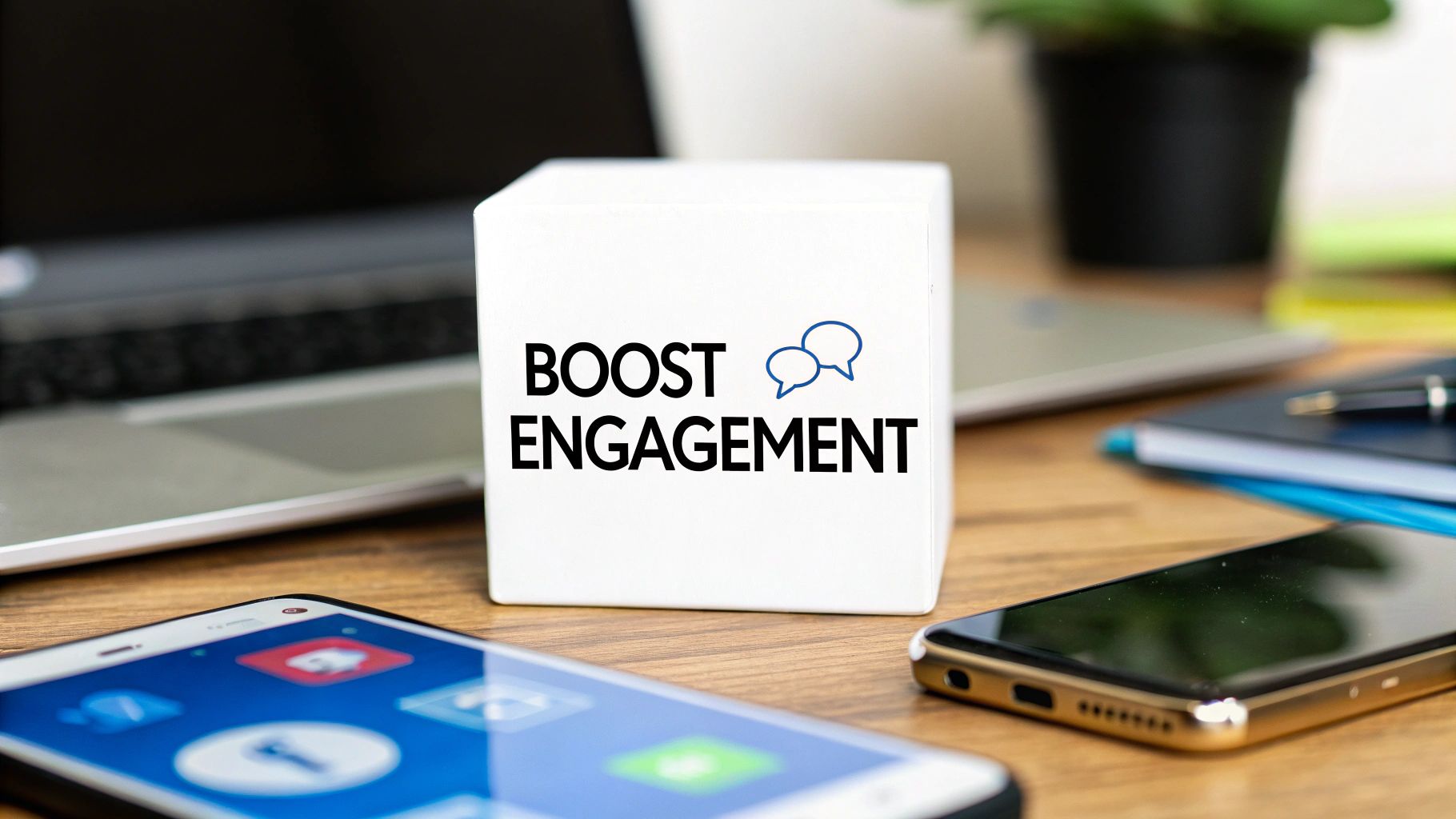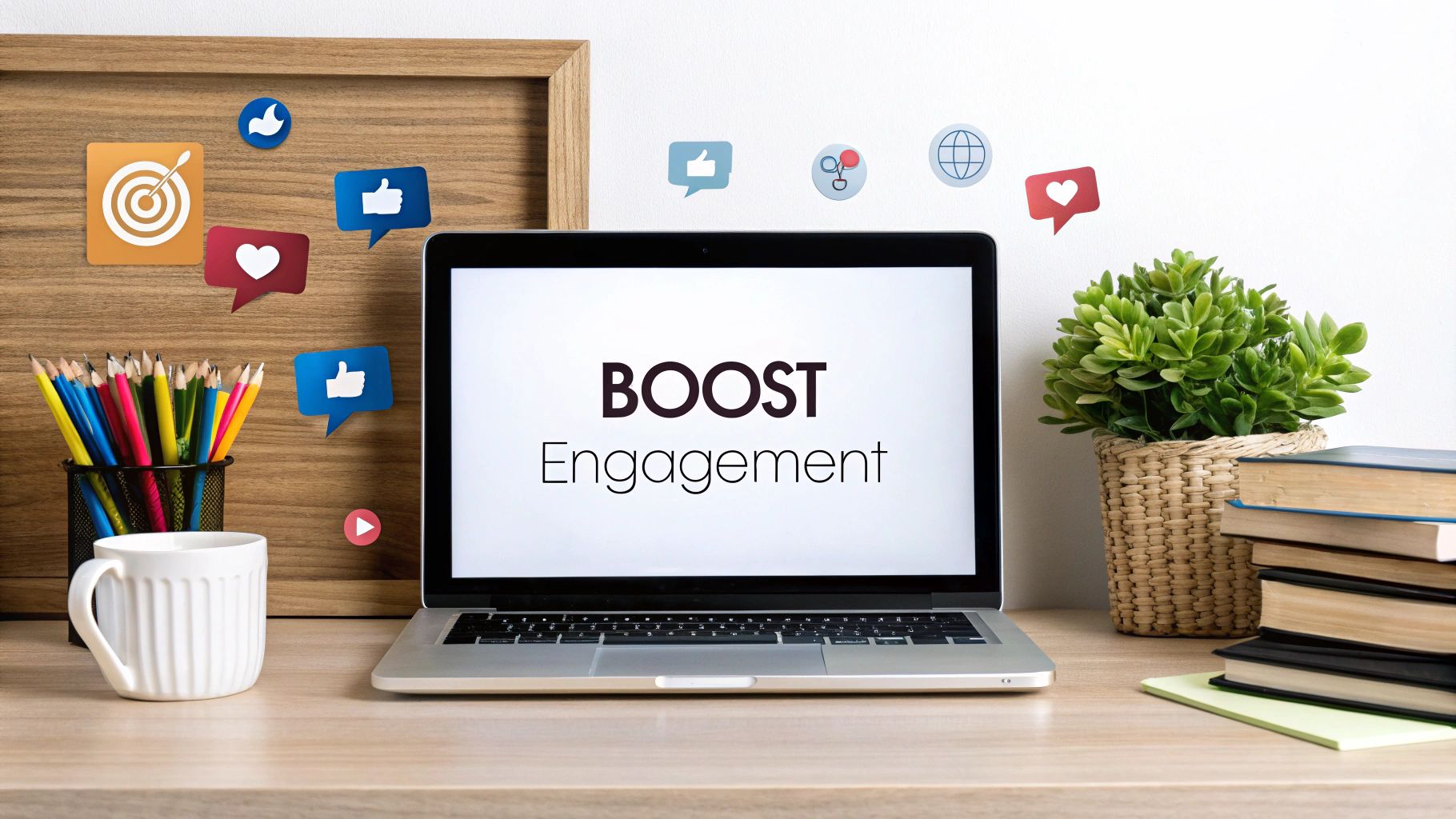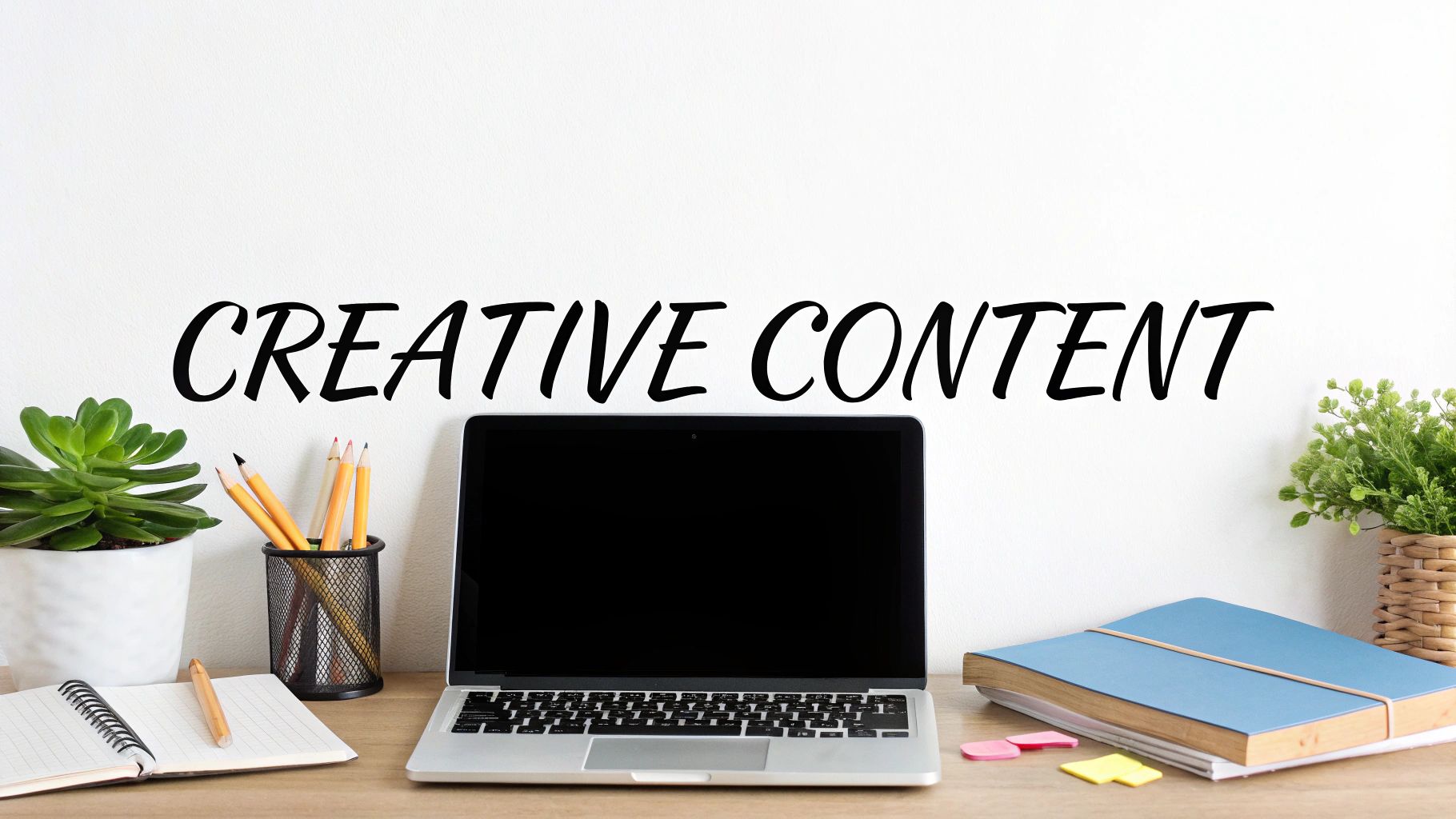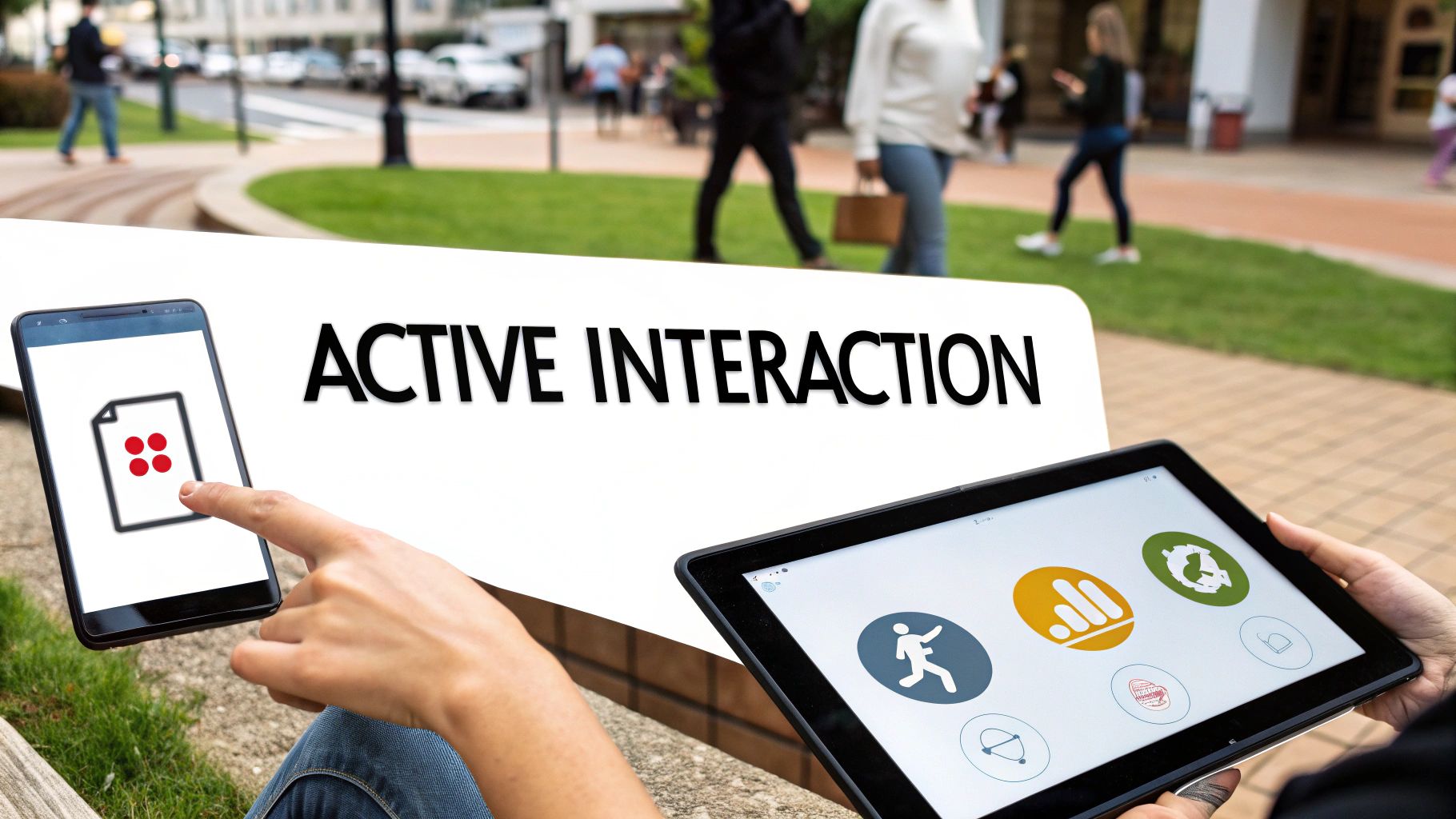Proven Tips: How to Boost Social Media Engagement

Decoding Platform-Specific Engagement: What Actually Works

Boosting your social media engagement isn't a one-size-fits-all strategy. What performs well on Instagram might not get the same traction on Facebook, and the reverse is also true. This means understanding the unique aspects of each platform is key to maximizing your reach. For example, Instagram's visual focus makes it perfect for showcasing products and lifestyle content. Meanwhile, LinkedIn, with its professional audience, is best suited for thought leadership and industry insights.
Understanding Platform Nuances
Different social media platforms attract different audiences, each with their own expectations and online behaviors. This impacts the type of content that resonates and how users engage. Instagram, for instance, thrives on visually appealing content like high-quality images and short, engaging videos. LinkedIn, on the other hand, prioritizes longer articles, professional networking, and industry-specific discussions. Tailoring your content to each platform is therefore essential.
Social media engagement rates are also heavily influenced by platform choice and content format. For example, Instagram's engagement rate in 2025 dropped to 0.50% (down 28% year-over-year). Yet, it still outperforms Facebook's 0.15% engagement rate by more than three times. YouTube boasts the largest advertising reach, with 2.53 billion monthly users and a massive active user base. At the same time, Instagram remains crucial for product discovery, with 61% of users using the platform to find new things to buy. Brands using interactive formats like Reels and Stories tend to see better results, with 69% of users reporting seeing the most engaging brand content on Instagram. What’s more, 72% of Gen Z prefers Instagram for customer service. Globally, the average user engages with 6.83 platforms, highlighting the need for cross-platform consistency. For deeper insights into these statistics, visit SproutSocial.
Tailoring Content for Maximum Impact
Consider these factors when creating content for different platforms:
Content Format: Short, engaging videos perform well on TikTok and Instagram Reels, while in-depth articles are better suited to LinkedIn.
Visual Appeal: High-quality images and graphics are essential for visually-driven platforms like Instagram and Pinterest.
Tone and Language: A professional tone is necessary for LinkedIn, while a more casual approach may work for Twitter or Instagram.
Posting Frequency: Each platform has its own rhythm. Over-posting can overwhelm your audience, while under-posting can lead to lower visibility.
To further illustrate the differences in engagement, let's examine a comparison of major social platforms:
To illustrate the differences in platform engagement, let's look at a comparison table:
Platform Engagement Rate Comparison
A direct comparison of average engagement rates across major social platforms
| Platform | Average Engagement Rate | YoY Change | Best Performing Content Types |
|---|---|---|---|
| 0.50% | -28% | Reels, Stories, High-Quality Images | |
| 0.15% | N/A | Video, Live streams | |
| YouTube | N/A | N/A | Long-form video, Educational content |
| N/A | N/A | Long-form articles, Industry Insights, Professional Networking | |
| N/A | N/A | News, Real-time updates, Short-form text |
This table highlights the significant disparity in engagement rates across platforms and reinforces the need for a platform-specific content strategy. While Instagram might see lower engagement rates than in previous years, it still outpaces Facebook, while platforms like YouTube and LinkedIn excel in different metrics entirely. Focusing on the right content types for each platform is key to maximizing your reach.
Measuring What Truly Matters
While likes and shares are important indicators, they don't tell the whole story. Focus on metrics that align with your specific business objectives. Are you trying to drive traffic to your website, generate leads, or build brand awareness? Track the metrics that reflect these goals. This might include click-through rates, website conversions, or brand mentions. By understanding platform best practices and tailoring your content accordingly, you can significantly boost your social media engagement and achieve meaningful results. Don't just post—strategize.
Video Content Mastery: Beyond Basic Recording

Video is undeniably powerful for boosting social media engagement. However, simply posting any video won't get results. A strategic approach to video creation is essential for capturing attention and driving interaction. Think of video content as a two-way conversation with your audience, not just a monologue.
Why Video Outperforms Other Content
Videos offer a dynamic and engaging format that surpasses text and static images. Combining visuals, audio, and motion creates a more immersive and memorable experience. This multi-sensory approach naturally encourages sharing and boosts engagement. Video also allows you to convey emotion and personality, building stronger connections with your audience.
Video remains a core driver of engagement. Facebook videos see a 0.17% engagement rate, just slightly behind status updates at 0.18% in 2023. However, platforms like TikTok and Instagram Reels are setting new standards, with short-form video fueling growth in social commerce. Global social media ad spending hit $207 billion in 2023, with Facebook accounting for 60% of revenue. The massive reach of platforms like TikTok (1.59 billion ad-reachable users) and YouTube (2.53 billion ad-reachable users) emphasizes the importance of video-focused strategies. For more statistics, check out this Shopify Blog on Social Media Marketing Statistics. Even on platforms experiencing declining usage, like Instagram, video content still outperforms text-based platforms.
Crafting Engaging Video Narratives
Storytelling is just as crucial for video. Focusing on narratives that resonate with your audience is key. Understanding your target viewers and their interests allows you to tailor video content to their specific needs and preferences. Consider relatable scenarios, incorporating user-generated content, and addressing real-world challenges your audience faces.
Looking to expand your content strategy? Explore our guide on How to Master LinkedIn Carousel Posts. These visually appealing posts complement your video efforts and build a more cohesive brand presence.
Optimizing Videos for Each Platform
Each social media platform has unique best practices for video content. Understanding these nuances is crucial for success. For instance, TikTok excels with short, catchy videos, while YouTube favors longer, more in-depth content. Pay attention to aspect ratios and technical specs for each platform to ensure optimal display.
The following table outlines optimal video specifications for various platforms, offering guidance on ideal length, aspect ratio, key features, and performance metrics.
Optimal Video Specifications By Platform
| Platform | Ideal Length | Aspect Ratio | Key Features to Utilize | Performance Metrics |
|---|---|---|---|---|
| TikTok | 15-60 seconds | 9:16 | Trending sounds, hashtags, effects | Views, likes, shares, comments |
| Instagram Reels | 15-90 seconds | 9:16 | Music, AR filters, interactive stickers | Reach, engagement, saves |
| YouTube | Varies (longer format preferred) | 16:9 | Chapters, end screens, playlists | Watch time, subscriber growth |
| Varies | 16:9 or 1:1 | Captions, targeted advertising | Reach, engagement, video views | |
| Short to medium length | 1:1 or 16:9 | Native video uploads, industry-specific content | Views, comments, shares |
This table provides a starting point for tailoring your video content to each platform's specific requirements, ultimately enhancing performance and reach.
Producing Engaging Videos on a Budget
Creating high-quality videos doesn't require a huge budget. Smartphones and free editing software provide powerful tools for producing compelling content, even with limited resources. Focus on strong visuals, clear audio, and concise storytelling to maximize impact without expensive equipment. Consider using natural lighting, filming in quiet locations, and exploring free or low-cost editing apps.
Creating Interactive Content That People Actually Want

Interactive content offers a powerful way to boost engagement on social media. However, it's crucial that these interactions feel authentic and not contrived. Many brands struggle to create interactive experiences that resonate with their target audience, often coming across as gimmicky or irrelevant. This section explores how to craft interactive content that genuinely captivates audiences, transforming passive scrolling into active participation. This fosters deeper connections and ultimately drives higher conversion rates.
Why Interactive Content Works
Interactive content generates twice the conversions compared to static content. This is because it actively involves the audience, encouraging them to invest their time and energy with your brand. This investment translates into improved brand recall and a strengthened sense of connection. A simple poll about audience preferences, for example, can ignite conversations and provide valuable feedback.
Interactive stories and quizzes can create memorable experiences that users readily share. This organic sharing amplifies your reach and further strengthens brand awareness. By actively engaging with your content, users become more invested in your brand’s message.
Designing Compelling Interactive Experiences
Developing effective interactive content requires thoughtful planning and execution. Consider these core strategies:
Understand Your Audience: Consider their interests, pain points, and preferred methods of online interaction. Tailor your interactive experiences to align with these specific preferences.
Focus on Value: The interaction itself must offer something valuable to the participant. This could be entertainment, educational information, or even the chance to win a prize. Providing value ensures that the interaction is mutually beneficial.
Keep it Simple and Intuitive: Complex or confusing interactions will discourage users. The experience should be seamless and easy to grasp, regardless of the user's technical proficiency.
Promote Participation: Clearly communicate the benefits of participating and encourage users to share their results with their network. This can create a ripple effect, expanding the reach of your content.
For further insights into creating engaging content, especially for a professional audience, check out our guide on 7 Types of Content to Boost Your Presence on LinkedIn.
Examples of Effective Interactive Content
Here are several examples of interactive content proven to enhance social media engagement:
Polls: Pose thought-provoking questions to initiate discussions and gather audience opinions. This can provide valuable insights into your audience's perspectives.
Quizzes: Test knowledge or personality traits in an enjoyable and engaging format. Quizzes can be a lighthearted way to interact with your audience while gathering data.
Interactive Stories: Craft immersive narratives that empower users to make choices and shape the story's outcome. This creates a personalized and memorable experience.
Contests and Giveaways: Offer incentives for participation with the opportunity to win a prize. This can significantly boost engagement and generate excitement around your brand.
Q&A Sessions: Host live Q&A sessions to interact with your audience in real-time, fostering a sense of community and direct engagement.
Measuring the Success of Your Interactive Content
Tracking the performance of your interactive content is critical. Key metrics to monitor include:
Participation Rate: How many users engaged with your interactive content? This provides a baseline measure of audience interest.
Completion Rate: What percentage of users completed the entire interaction? This indicates how engaging the content was and how effectively it held users' attention.
Share Rate: How often did users share their results or the content itself? This reveals how shareable and resonant your content is.
Conversion Rate: Did the interaction lead to the desired outcomes, such as increased website visits or product purchases? This measures the effectiveness of your content in driving tangible results.
By analyzing these metrics, you can refine your interactive content strategy, creating even more engaging experiences. This data-driven approach allows for continuous optimization. Consistent experimentation with different formats and actively gathering audience feedback are essential for creating truly resonant interactive content.
Building Community Through Authentic Conversation

True social media engagement goes beyond simple metrics like likes and shares. It's about fostering genuine connections and a sense of belonging. Leading brands understand this, prioritizing interactive communities where their audience feels valued. This transforms passive followers into active brand advocates.
This section explores how to cultivate such a community through authentic conversations, turning your social media presence into a dynamic hub of interaction.
Crafting Conversations That Resonate
One of the best ways to elevate social media engagement is by sparking meaningful dialogues. Think of your social media platform not as a broadcasting tool, but as a space for two-way communication. This requires shifting from purely promotional content to asking questions that genuinely pique interest.
Consider posing open-ended questions that encourage a variety of perspectives. For example, instead of just showcasing a new product, ask your audience about the challenges they encounter related to that product's functionality.
Additionally, tailor your questions to the specific interests and needs of your target audience. A question that resonates with a Gen Z audience on TikTok might not land well with professionals on LinkedIn. Understanding your audience is crucial for creating conversations that truly connect.
Moderating for Authenticity and Engagement
Effective moderation is key to maintaining a positive and engaging community. It's a delicate balancing act. While clear guidelines are essential, overly strict moderation can stifle genuine expression and discourage participation.
The goal is to create a space where users feel comfortable sharing their thoughts while maintaining a respectful environment. This involves addressing inappropriate behavior swiftly while simultaneously promoting open and honest dialogue.
For example, responding to negative comments with empathy and offering solutions can turn a potentially damaging interaction into a positive customer service opportunity. This demonstrates that you value all feedback and are dedicated to resolving issues.
Encouraging User-Generated Content
User-generated content (UGC) is a valuable asset for boosting social media engagement. It offers authentic social proof and motivates active participation within your community. However, simply requesting UGC isn't always effective.
Instead, create opportunities and incentives that inspire your audience to contribute organically. This could involve launching themed challenges, highlighting top contributors, or offering exclusive previews of new products.
This means structuring community challenges that are enjoyable, accessible, and relevant to your brand. For example, a fashion brand could challenge followers to style a specific item in their own unique way. This not only generates engaging content but also provides valuable social proof for potential customers.
Establishing a Human Brand Voice
Finally, developing a consistent and relatable brand voice is essential for building an authentic community. Avoid sounding overly corporate or impersonal. Instead, infuse your communications with personality and humor, making your brand feel approachable and genuine. This fosters a sense of connection and encourages interaction.
This involves responding to comments and messages promptly and personally. Address your audience by name, acknowledge their feedback, and show genuine interest in their perspectives. Think of it as having a conversation with a friend, not broadcasting to a large, impersonal audience. By nurturing these authentic connections, you transform your social media presence into a thriving community, boosting engagement, and building lasting brand loyalty.
Strategic Post Timing: When Matters More Than What
Timing your social media posts strategically is as important as the content itself. It significantly impacts engagement, more than many people realize. A surprising number of brands still rely on outdated posting schedules, missing valuable opportunities to connect with their target audience. This section explores how understanding platform algorithms and audience behavior can help you maximize your content’s reach.
Dismantling Timing Myths
Common misconceptions about post timing can negatively affect your engagement efforts. One persistent myth is the idea of a universally "best" time to post across all platforms. This simply isn't true. Each platform has its own unique rhythm and audience activity patterns. Another misconception is that posting more frequently automatically translates to higher engagement. Over-posting can actually overwhelm your audience and lead to less interaction overall. Quality over quantity should be your guiding principle.
Identifying Peak Engagement Windows
To boost your social media engagement, it's crucial to understand when your audience is most active online. This involves analyzing platform analytics and understanding audience behavior. For instance, you might find that LinkedIn engagement peaks during business hours, while Instagram sees higher activity during the evenings.
Tools like Hootsuite Analytics offer valuable insights into your audience's online behavior, helping you pinpoint optimal posting windows. These tools track post performance and identify patterns in engagement. Remember to consider the time zones of your target audience, especially if you have a global reach.
Optimizing Posting Frequency
The ideal posting frequency differs across various platforms. While consistent posting is important, excessive posting can be detrimental. Posting multiple times a day on LinkedIn, for example, might be overkill, while frequent posts on Twitter are more common and accepted. Experimentation is key. Find the “sweet spot” for each platform, maintaining visibility without overwhelming your followers. Analyze your engagement metrics after adjusting your frequency to see what works best.
Tools and Techniques for Efficient Scheduling
Several tools simplify content scheduling and optimize post timing. Lumeo allows you to create engaging video content. Scheduling features within Hootsuite and other social media management platforms let you plan and automate your posts. This helps you maintain a consistent presence without constant manual posting. These tools also facilitate A/B testing different posting times, ensuring your content reaches the right audience at the optimal moment.
Continuously Refining Your Strategy
Effective social media engagement requires ongoing refinement and adaptation. Track your results and adjust your posting schedule based on the data you collect. Regularly analyze your engagement metrics – likes, comments, shares, and click-through rates – to understand what resonates with your audience. This iterative process, combined with A/B testing, ensures your content strategy stays aligned with audience behavior and algorithm changes. This data-driven approach moves you beyond guesswork and towards a truly effective strategy.
Leveraging Platform Features Most Brands Underutilize
Boosting social media engagement goes beyond simply creating good content. It requires understanding and using the often forgotten features each platform offers. Many brands concentrate only on basic posting, neglecting valuable opportunities to boost visibility and interaction. This section explores some of these underutilized tools and shows how they can enhance your engagement strategy. It's about mastering the specific features of each platform, like learning a secret handshake to get noticed.
Hidden Gems on Instagram
Instagram provides a range of tools beyond basic image and video posts. Interactive stickers in Stories, like quizzes, polls, and question stickers, encourage active participation and gather valuable audience feedback. Instagram Guides let you curate content around specific themes, creating a resource hub for followers. This adds value beyond individual posts and positions your brand as a knowledgeable voice in your area. Embracing new features early on, such as collaborative posts and live audio rooms, can give you a competitive advantage.
Twitter Beyond 280 Characters
Twitter offers opportunities for real-time engagement. Twitter Spaces, its live audio feature, enables direct conversations with your audience. This fosters a sense of community and builds deeper connections. Hosting Q&A sessions, discussions, or even casual chats can significantly boost engagement and strengthen relationships with followers. Using Twitter lists effectively lets you segment your audience and deliver more focused content.
LinkedIn for Professional Engagement
For those wanting to understand the complexities of the LinkedIn algorithm to improve their presence, see our guide: Understanding the 2024 LinkedIn Algorithm. This platform is full of underused features. LinkedIn Newsletters help you establish thought leadership and deliver valuable content straight to subscribers' inboxes. This provides consistent engagement beyond the main feed. Participating actively in relevant LinkedIn Groups exposes your brand to a larger audience and positions you as a leader in your field. This targeted networking can create valuable connections and boost your brand’s authority.
Maximizing Reach With Early Adoption
New platform features present a unique chance to significantly increase reach organically. Early adopters often gain increased visibility, as algorithms tend to favor and highlight new functionality. Being among the first to try new tools can give your content a noticeable boost in crowded social media feeds.
Creative Implementations for Standout Content
Don't just use platform features—use them creatively. Instead of basic Instagram polls, try using them to crowdsource content ideas or get product feedback. On Twitter, use Spaces to host exclusive interviews or offer behind-the-scenes looks. Thinking outside the box can substantially increase interaction and elevate your brand. This creative approach transforms routine features into memorable engagement opportunities.
Integrating Tools Into Your Content Plan
Don't add these features as an afterthought. Strategically integrate them into your content plan. For example, schedule regular Twitter Spaces sessions to discuss industry news. Plan a series of Instagram Guides related to your core products or services. Create a LinkedIn Newsletter to share exclusive company news or thought leadership pieces. By purposefully incorporating these features, you will build a stronger and more engaging social media presence, making your brand a true platform expert. This focused integration makes platform features into powerful engagement drivers, differentiating you in a competitive digital space.
Measuring What Matters: Beyond Vanity Metrics
Boosting social media engagement involves more than accumulating likes and shares. True success lies in understanding which metrics genuinely correlate with business outcomes. This requires looking beyond vanity metrics and focusing on data that provides actionable insights. This section offers a framework for measuring what truly matters, drawing upon expertise from data-driven social media directors.
Identifying Meaningful Engagement
While likes and shares contribute to overall visibility, they don't necessarily translate to tangible results. Meaningful engagement indicates actions that align with your business objectives. For example, if your goal is to drive website traffic, click-through rates become a critical metric.
If lead generation is your focus, then form submissions or contact requests hold greater significance. Defining your goals upfront allows you to identify the metrics that reflect real progress.
Setting Realistic Benchmarks
Comparing your performance against industry standards and competitors provides context for your results. However, generic benchmarks can be misleading. Consider factors like audience size and industry when evaluating your engagement levels.
A smaller, highly engaged audience can be more valuable than a larger, passive one. Understanding your target demographic helps establish realistic and relevant benchmarks for success. This means analyzing your audience's online behavior to understand their preferred platforms and content formats.
Connecting Engagement to Business Outcomes
The ultimate measure of social media success is its impact on your bottom line. This involves connecting engagement metrics to business goals. For example, track how increased engagement translates into website conversions or sales.
This requires implementing tracking mechanisms to connect social media activity to business outcomes. Use tools like Google Analytics to measure website traffic originating from social media and attribute conversions to specific campaigns. This data-driven approach demonstrates the tangible value of your social media efforts.
Establishing an Effective Testing Methodology
Continuous improvement requires ongoing testing and optimization. This includes establishing an A/B testing framework to experiment with different content formats, posting times, and calls to action.
Analyze the results of these tests to understand what resonates best with your audience and drives the desired outcomes. Regularly audit your content to identify high-performing posts and replicate their success. This data-informed approach ensures your strategy evolves and stays effective.
Interpreting Engagement Analytics
Platform analytics provide a wealth of information about audience preferences. Learn how to interpret this data to understand what content types, posting times, and interactive elements perform best.
This involves diving deeper than just surface-level metrics like likes and shares. Analyze comment sentiment, video watch time, and story interactions to uncover deeper insights about what resonates with your audience. This deeper understanding allows you to refine your content strategy and maximize engagement.
Creating Reporting Dashboards
Communicating the value of your social media efforts to stakeholders requires clear and concise reporting. Create dashboards that showcase key engagement metrics and their impact on business outcomes.
Focus on metrics that align with your business objectives and demonstrate a return on investment. For example, showcase how increased engagement has translated into lead generation or sales growth. This data-driven approach demonstrates the value of your social media activities and justifies ongoing investment.
Boost your social media engagement today with Lumeo, the platform that transforms ordinary content into captivating carousel presentations. Turn your articles, tweets, and videos into dynamic visuals that maximize engagement and drive results. Visit Lumeo to learn more and start creating compelling content that captures attention.